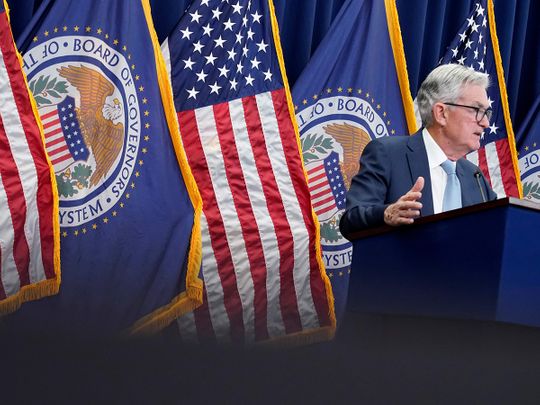
The world’s major central banks meet in the coming week to set monetary policy amid continued signs that the worst inflation crisis in decades is easing.
While the Federal Reserve and European Central Bank are each expected to raise interest rates by 25 basis points, the greater focus will be on signaling from policy makers on whether more hikes are likely - or if they plan an extended pause.
Both Fed Chair Jerome Powell and ECB President Christine Lagarde have warned that inflation remains too high, forcing them to raise borrowing costs further. But with neither central bank meeting again until September, economists say the outlook for policy into the back end of the year remains open-ended.
Read more
- UK inflation slows sharply to 7.9% in June
- US economy adds 209,000 jobs in June as hiring slows
- Britons swap beach holidays for city breaks as rate rises bite
- UAE Central Bank issues measures to limit impact of interest rate hikes on housing loans
- London new home sales tumble to lowest since 2012 as rates weigh
The Bank of Japan remains the outlier, with more than 80 per cent of analysts polled expecting Governor Kazuo Ueda to continue pumping support into the world’s No. 3 economy even as inflation remains above their 2 per cent target.
Here’s a look at the major central bank decisions due this week:
Federal Reserve
Fed policymakers are poised to hike rates on Wednesday to the highest rate in 22 years, while retaining a tightening bias that signals the possibility of an additional move later in the year.
The Federal Open Market Committee is expected to raise rates quarter point to the 5.25-5.5 per cent range, an 11th increase over the past 16 months.
The July hike follows a pause in June that was intended to slow the pace of increases as rates approach a level believed to be restrictive enough to return inflation to the 2 per cent target over time. Still, Powell and other policymakers will want to sound resolute and keep options open to hike again if necessary to avoid recurrences of surging prices.
“Inflation is slowing, but not quickly enough for the Fed,” said James Knightley, chief international economist at ING Financial Markets LLC. “With the jobs market remaining firm, officials are taking no chances.”
European Central Bank
With a quarter-point rate hike this week all but guaranteed, all eyes will be on how Lagarde characterises the ECB’s policy plans beyond July. Officials have stressed for some time that decisions will be based on incoming data, and September may be the first month where they actually stick to that idea.
Saying nothing would break with a well-established habit of de-facto pre-committing to the very next move. Such a change in tactic may become necessary, though, as the ECB approaches the end of the most aggressive tightening cycle in its 25-year history.
Policymakers have lifted the deposit rate by 400 basis points since last July, and economists surveyed by Bloomberg expect two more steps, in July and September, which would take the benchmark to 4 per cent.
Most of that tightening still has to reach the economy, and much of the recent public debate has focused on whether what’s already in the pipeline will be sufficient to bring inflation back to 2 per cent, or if more is needed.
While a fresh survey of banks’ lending behavior on Tuesday will likely show that loan demand and credit standards deteriorated further in the second quarter, underlying price pressures remain unexpectedly strong.
By the time the Governing Council comes back from its summer break in September, it will be able to draw on two more inflation reports, an overview of the economy’s performance in the second quarter, and updated projections - along with several other sets of data - to make up its mind.
Bank of Japan
Ueda continues to signal that a major pivot toward tighter policy is some ways off, even as prices continue to rise at a faster pace than the BOJ’s 2 per cent inflation target.
More than 80 per cent of economists surveyed by Bloomberg now see the central bank leaving all its policy levers untouched on Friday. The remainder expect another widening of the band around the BOJ’s yield target, or a similar tweak. The previous survey showed around a third forecasting change in July.
Still, lingering price stickiness is widely seen prompting the BOJ to raise its inflation forecast for this year. That looming revision has been one of the main sources of speculation that the BOJ would tinker with its stimulus measures in July. People familiar with the matter told Bloomberg that officials see little urgent need to address the side-effects of its yield curve control program at this point, although they expect to discuss the issue.
But the market chatter has weakened as Ueda continues to reiterate his assumption that, for now, the price goal looks some distance away. Barring a surprise this week, BOJ watchers now view the next release of quarterly price projections in October as the most likely timing for any move.










